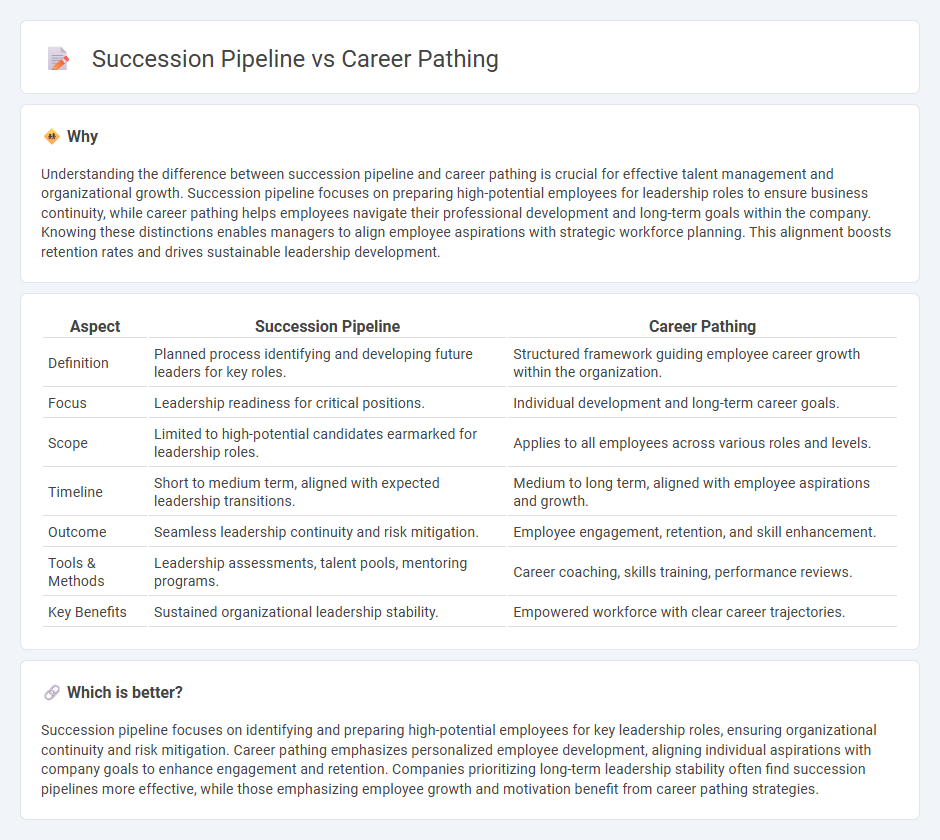
Succession pipeline focuses on identifying and preparing high-potential employees for key leadership roles to ensure organizational continuity, while career pathing provides employees with clear, personalized progression routes aligned with their skills and aspirations. Both strategies enhance talent retention and workforce development by aligning employee growth with business goals. Discover how integrating succession pipeline and career pathing can transform your management approach.
Why it is important
Understanding the difference between succession pipeline and career pathing is crucial for effective talent management and organizational growth. Succession pipeline focuses on preparing high-potential employees for leadership roles to ensure business continuity, while career pathing helps employees navigate their professional development and long-term goals within the company. Knowing these distinctions enables managers to align employee aspirations with strategic workforce planning. This alignment boosts retention rates and drives sustainable leadership development.
Comparison Table
| Aspect | Succession Pipeline | Career Pathing |
|---|---|---|
| Definition | Planned process identifying and developing future leaders for key roles. | Structured framework guiding employee career growth within the organization. |
| Focus | Leadership readiness for critical positions. | Individual development and long-term career goals. |
| Scope | Limited to high-potential candidates earmarked for leadership roles. | Applies to all employees across various roles and levels. |
| Timeline | Short to medium term, aligned with expected leadership transitions. | Medium to long term, aligned with employee aspirations and growth. |
| Outcome | Seamless leadership continuity and risk mitigation. | Employee engagement, retention, and skill enhancement. |
| Tools & Methods | Leadership assessments, talent pools, mentoring programs. | Career coaching, skills training, performance reviews. |
| Key Benefits | Sustained organizational leadership stability. | Empowered workforce with clear career trajectories. |
Which is better?
Succession pipeline focuses on identifying and preparing high-potential employees for key leadership roles, ensuring organizational continuity and risk mitigation. Career pathing emphasizes personalized employee development, aligning individual aspirations with company goals to enhance engagement and retention. Companies prioritizing long-term leadership stability often find succession pipelines more effective, while those emphasizing employee growth and motivation benefit from career pathing strategies.
Connection
Succession pipeline and career pathing are interconnected by facilitating the identification and development of internal talent for future leadership roles. Effective career pathing maps clear progression routes, aligning employee growth with the organization's long-term succession planning goals. This strategic alignment ensures a steady flow of qualified candidates ready to assume critical positions, enhancing organizational continuity and leadership stability.
Key Terms
Individual Development Plan (IDP)
Career pathing centers on creating a personalized Individual Development Plan (IDP) that aligns an employee's skills, interests, and career goals with company opportunities for growth and advancement. The succession pipeline emphasizes identifying and preparing high-potential employees to fill key leadership roles, often through targeted development activities reflected in the IDP. Explore how blending career pathing with succession planning maximizes organizational talent development and readiness.
Talent Pool
Talent pool management within career pathing emphasizes individual growth by identifying skill gaps and promoting continuous learning, whereas succession pipeline development prioritizes ready-to-fill leadership roles through targeted high-potential talent identification. Both strategies optimize organizational readiness but differ in focus; career pathing fosters broad employee development while succession pipelines ensure leadership continuity. Explore deeper insights into how talent pools can be strategically leveraged for workforce optimization.
Leadership Bench Strength
Career pathing emphasizes individual development through tailored skill-building and role progression to enhance leadership bench strength. Succession pipeline focuses on identifying and preparing high-potential employees to ensure a continuous flow of qualified leaders ready to step into critical roles. Explore strategies to integrate both approaches for a robust leadership development framework.
Source and External Links
What Is Career Pathing & Why Is It Important? - Paychex - Career pathing is the process employers use to create a customized development plan that aligns an employee's skills, interests, and opportunities with career objectives, mapping possible roles and growth steps to achieve short- or long-term goals within or beyond the organization.
Career Pathing: The Complete Guide - Qualtrics - Career pathing can follow a traditional linear "career ladder" toward promotions or a more flexible "career lattice" involving lateral moves and new roles, supporting personalized professional growth.
Improve Employee Development with Career Pathing | Chronus - Effective career pathing involves employee self-assessment, individualized career mapping with management, and exploration of relevant opportunities, which increases engagement and helps retain top talent.
 dowidth.com
dowidth.com